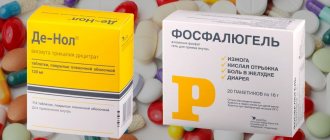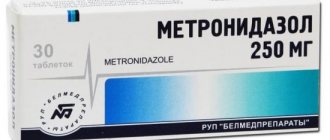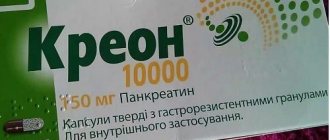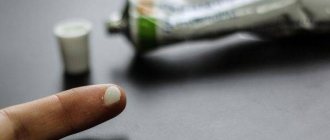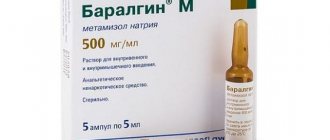Registration authorization holder: ASTELLAS PHARMA EUROPE, BV (Netherlands) Manufactured by: R-PHARM (Russia) or ASTELLAS PHARMA EUROPE (Netherlands) Packaging, packaging and release quality control: ASTELLAS PHARMA EUROPE (Netherlands) or R-PHARM (Russia) Or packaging , packaging and releasing quality control: ORTAT (Russia) ATX code: A02BX05 (Bismuth subcitrate) Active substance: bismuth tripotassium dicitrate (bismuthate, tripotassium dicitrato)
Introduction to De-Nol
De-Nol is one of the modern remedies that is medicinal for the digestive system with an antiseptic effect and has an anti-inflammatory effect in the stomach cavity. Supplied in tablets. De-Nol tablets are used for acute gastritis. They cover the gastric mucosa with a thin protective layer, which helps protect it from the action of bile, gastric juice, and the contents of digested food. The tablets improve the process of the appearance of new cells, the healing process of minor ulcers and erosions, and have an anti-inflammatory effect. Let's consider how to use de Nol for gastritis, what dosage, duration of use and many other issues. This medicine is used only as prescribed by a doctor.
Main indications and contraindications
The effectiveness and high digestibility of the drug has been proven for the following diseases:
- Stomach ulcer.
- Duodenal ulcer.
- Dyspeptic syndrome.
- Irritable bowel syndrome.
- Chronic gastritis type B.
- Ellison-Zollinger syndrome.
When prescribing De-nol for gastritis, you need to remember the contraindications that the drug has. It is not recommended to be treated with Denol for patients suffering from acute or chronic renal failure, especially severe ones. A relative contraindication is considered hypersensitivity or individual intolerance to the drug or individual biochemical components. De-nol is not prescribed for gastritis with low acidity.
An absolute contraindication to taking de-nol will be the period of gestation and breastfeeding. The drug has a pronounced teratogenic effect. If gastritis or peptic ulcer worsens in a pregnant woman, she will have to choose safer drugs.
Dosage form and packaging of De-Nol
De-nol is produced in the form of round, smooth, light cream tablets, biconvex shells. The tablets have no odor. To avoid purchasing a counterfeit, you need to look carefully at the capsule: on one side there is a pattern in the form of a square, on the second side it says gbr 152. The package contains seven or fourteen blisters of eight tablets.
During a course of complex therapy for the treatment of gastritis, you need to choose the right diet in order to restore digestive functions. It is prohibited to use the drug together with other medications.
Review of the drug De-Nol - instructions for use reviews
De-Nol is an antiulcer drug.
Active substance
The active substance in the drug is bismuth tripotassium dicitrate or colloidal bismuth subcitrate.
Chemical name: bismuth (III) potassium 2-hydroxy-1,2,3-propanetricarboxylate (salt 1:3:2). Formula: C12H10BiK3O14.
Mechanism of action
De-Nol belongs to the group of gastroprotectors - medicines that protect the gastric mucosa from aggressive factors.
Those with peptic ulcers are increased acidity of gastric juice and Helicobacter pylori. And there is a close relationship between them.
Moreover, Helicobacter pylori or Helicobacter is the leading cause of the development of gastric and duodenal ulcers. These gram-negative bacteria, which have a spiral shape and are equipped with flagella, live on the mucous membrane of the pylorus (pylorus) of the stomach, but are almost never found in the duodenum (duodenum).
Cells of various parts of the gastric mucosa produce many substances or factors that make up the gastric juice. The most important of them are pepsinogen and hydrochloric acid. Under the influence of hydrochloric acid, pepsinogen is transformed into the active form pepsin.
This digestive enzyme provides proteolysis - the breakdown of protein compounds that enter the stomach as part of food. The secretion of gastric juice, its volume, composition, acidity depends on many regulatory mechanisms. Among them are food intake, various hormones, and the state of the autonomic nervous system.
Under the influence of parasympathetic vegetative impulses, secretion increases, the acidity of gastric juice increases, and under the influence of sympathetic impulses, on the contrary, it is inhibited. Hydrochloric acid, pepsin and other proteolytic digestive enzymes have a negative effect on the gastric mucosa.
With their excessive secretion, self-digestion of the mucous membrane occurs with the formation of ulcerative defects. It is this mechanism (pathogenesis) that underlies ulcer formation.
Gastroprotection, the protection of mucous membranes from the aggressive influence of gastric juice, is achieved by several mechanisms. Mucus is secreted onto the surface of the mucous membrane by superficial or accessory cells, which serves as good mechanical protection.
These same cells secrete bicarbonates, which, being alkalis, neutralize the hydrochloric acid of gastric juice. The formation of mucus and bicarbonates is carried out under the influence of prostaglandins. These biologically active hormone-like substances are synthesized in various tissues of the body, and the functions they perform are equally different.
Prostaglandins regulate blood pressure, smooth muscle tone of internal organs, hormone levels, the development of inflammatory reactions, and much more. In this regard, there are several types of prostaglandins, which are designated in capital letters of the Latin alphabet.
The formation of mucus and bicarbonates is ensured by prostaglandins E, which have two types - E1 and E2. With a deficiency of prostaglandins E1/E2, the amount of mucus and bicarbonates decreases, and the mucous membrane becomes more susceptible to the destructive effects of gastric juice.
If mucus with bicarbonates is the first, superficial protective barrier, then the second, deep barrier will be the mucous membrane itself. The better the blood supply in it, the faster its cells are renewed, the stronger it is.
The so-called plays a certain role in ensuring the strength of the gastric mucosa. epidermal growth factor. This is a specific protein that ensures the growth and differentiation of the gastric mucosa.
Until recently, it was believed that due to the high acidity of gastric juice, the growth and reproduction of pathogenic microorganisms in the stomach is fundamentally impossible. It turned out that this is not so, and Helicobacter “successfully” multiplies on the gastric mucosa.
These bacteria secrete enzymes that break down the protein components of the mucous membrane. Proteolysis is accompanied by the formation of energy, which ensures the vital activity of bacteria.
At the same time, they are also susceptible to the harmful effects of gastric juice. To adapt to an unfavorable aggressive environment, Helicobacter has developed a number of protective and adaptive mechanisms. These microbes live in the thickness of gastric mucus at the border with the cells of the mucous membrane, where acidity is minimal.
At the same time, they are able to penetrate deep into the submucosal layer. To protect themselves from excess acidity, they secrete the enzyme urease, which converts tissue urea into ammonia. Ammonia is an alkali that corrodes fabric. In response to the presence of alkali, the mucous membrane secretes even more hydrochloric acid with further activation of pepsinogen and the formation of pepsin.
In this case, Helicobacter produces even more ammonia. The vicious circle closes, and irritation of the mucous membrane by ammonia in combination with self-digestion processes leads to the formation of ulcerative defects. Although there is no Helicobacter in the duodenum, the entry of acidic gastric contents into the duodenal lumen leads to similar changes.
The strength of the duodenal mucosa decreases, it becomes more susceptible to the irritating action of bile acids, which come from the liver and gallbladder in the composition of bile.
It is noteworthy that duodenal ulcers are much more common than gastric ulcers. In most cases, peptic ulcer disease is preceded by the so-called. pre-ulcerative conditions. These conditions are characterized by inflammation of the mucous membrane of the stomach and duodenum (gastroduodenitis) and the presence of surface defects (erosions).
Helicobacter infection occurs through saliva when using shared utensils or when kissing. In the external environment, these bacteria quickly die.
However, up to 80% of the world's population is infected with these bacteria. Of course, not everyone suffers from peptic ulcers. For destructive changes to appear on the mucosa and the development of corresponding symptoms, there must be some provoking factors.
These are an unbalanced diet, weak immunity, stress, taking certain medications - everything that was previously considered the main causes of peptic ulcers and duodenal ulcers.
How does De-Nol affect the ulcerative process? Bismuth tripotassium dicitrate (hereinafter referred to as BTD) is practically not absorbed into the gastrointestinal tract. When it enters the gastrointestinal tract, salts are formed - bismuth citrate and bismuth oxychloride. These salts, upon contact with the proteins of the gastric mucosa, form complex organometallic complexes or chelates.
Macroscopically, the synthesis of chelates is manifested by the formation of films on the surface of erosive and ulcerative defects. These films have the appearance of a whitish foamy coating and protect the damaged mucosa from the action of hydrochloric acid and pepsin. Under the influence of VTD, the activity of pepsinogen and pepsin decreases. The drug stimulates the formation of prostaglandins E, and thereby increases the production of mucus and bicarbonates.
The amount of epidermal growth factor in mucosal tissue also increases. As a result, the regenerative ability of the gastric mucosa increases. Blood circulation in the submucosal layer improves, local inflammatory reactions are inhibited.
VTD acts not only on the pathogenesis of peptic ulcer disease, but also on its immediate cause, Helicobacter. The drug is able to penetrate into microbial cells. In this case, the synthesis of urease and other proteolytic enzymes is disrupted, and the ability of microbial cells to attach to mucous tissues is lost. Ultimately, the Helicobacter cell membrane is destroyed and it dies.
Thus, De-Nol has a complex astringent, antacid (anti-acid), anti-inflammatory and bactericidal effect on ulcers, which leads to scarring of the ulcer with further elimination of symptoms of pain and digestive disorders in peptic ulcers. True, its bactericidal activity is not too high.
If treatment is carried out with De-Nol alone (monotherapy), then complete destruction or eradication of Helicobacter can be achieved only in 30% of patients. With the combination of De-Nol and antibacterial drugs, in particular Amoxicillin, Metronidazole, the eradication rate reaches 80% or higher.
It is noteworthy that VTD can be useful not only for peptic ulcers, but also for hyperacid (high acidity) gastritis, regardless of their connection with Helicobacter. The astringent and anti-inflammatory effect of De-Nol has found application in some intestinal disorders, in particular irritable bowel syndrome.
This is not an independent disease, but a complex of symptoms that has developed for many reasons. Manifested by bloating, abdominal pain, flatulence, diarrhea. With the use of De-Nol, these symptoms regress.
In addition, De-Nol is prescribed for the so-called. microscopic colitis - inflammation of the large intestine without pronounced changes in the mucous membrane and deeper layers. The disease is diagnosed only on the basis of specific histological features during mucosal biopsy. The drug is well tolerated by patients.
Despite the fact that bismuth salts are practically not absorbed into the gastrointestinal tract, a certain amount of the drug is still absorbed. Once in the blood plasma, it is excreted by the kidneys.
However, with prolonged excess of recommended dosages and with concomitant kidney damage, bismuth accumulates in the central nervous system, where it causes toxic encephalopathy - brain damage characterized by headache, dizziness, sleep disorders, thinking and memory.
Synthesis technology
In the production of De-Nol tablets, along with VTD, excipients are used: sodium polyacrylate, povidone, corn starch, magnesium stearate, macrogol. The tablet shell consists of macrogol and hypromellose.
A little history
The astringent and anti-inflammatory properties of bismuth were discovered a long time ago. Since the 16th century, it has been used in the treatment of gastrointestinal diseases. In the 70-80s of the last century, several drugs based on bismuth salts were synthesized. Of these, the VTD deserved the most attention, which began to be produced under different names.
It was originally prescribed as an astringent and antacid. However, then, when the connection between peptic ulcer disease and Helicobacter was established, the bactericidal properties of the drug were discovered. Side effects were rare, and the medicine began to be prescribed uncontrollably, often in excess of dosages. Soon, cases of encephalopathy became more frequent.
Therefore, De-Nol and its analogues were soon banned in a number of Western European countries. However, it has been approved as an over-the-counter drug in the United States and Canada. De-Nol is actively used as an antiulcer drug in Russia and most CIS countries.
Interesting Facts
Helicobacter was identified in the 70s of the last century. However, at first its role in the development of peptic ulcers was denied. It was believed that the basis of this disease was an unbalanced diet, nervous stress, etc.
To prove he was right, one of the scientists who studied Helicobacter, Marshall, drank a solution of a nutrient medium with these microorganisms. After some time, he developed gastritis.
The presence of Helicobacter was confirmed by microscopy of Marshall's stomach contents. Then, during a two-week course of treatment using antibacterial agents and bismuth salts, gastritis was successfully cured.
Release form
Tablets containing 304.6 mg of BTD, which corresponds to 120 mg of bismuth oxide.
De-Nol is produced by Astellas in the Netherlands. You can also find Turkish or Indian De-Nol on the Russian consumer market. There are other generics with the active ingredient VTD. These are Novobismol, a product of the Russian Pharmstandard, and Ventrisol, a product of the Polish Poznan.
In gastroenterology, other Bismuth preparations are used as antacids and antiulcer agents. This is Bismuth subcitrate and Bismuth nitrate basic (a mixture of bismuth salts) in the composition of Vikalin and Vikair tablets. However, at present these drugs are practically not used.
Among the antacids and coating agents with other active substances that are used in the treatment of gastric ulcers are Almagel (Gastal, Maalox), Venter (Sucralfate), Gaviscon, Rennie, Phosphalugel.
Indications
- Peptic ulcer of the stomach and duodenum in the vase of exacerbation;
- Chronic gastritis and gastroduodenitis in the acute stage, incl. and associated with Helicobacter;
- Irritable bowel syndrome with diarrhea;
- Functional digestive disorders not associated with organic lesions of the gastrointestinal tract.
Dosages
- Adults and children over 12 years of age take 4 tablets per day, or 2 tablets 2 times a day;
- Children from 8 to 12 years old take 1 tablet 2 times a day;
- Children from 4 to 8 years old take the drug at the rate of 8 mg/kg body weight, which corresponds to 1-2 tablets per day.
Ingestion of solid foods, milk and drinks may weaken the effect of De-Nol. Therefore, tablets are taken half an hour before meals or at night, washed down with a small amount of water. The course of treatment with De-Nol is 4-8 weeks.
To avoid bismuth intoxication, it is not recommended to exceed the course duration or recommended dosages. You should also not take other bismuth preparations during treatment with De-Nol and in the first 8 weeks after the end of the course.
Pharmacodynamics
Most of the VTD taken orally is not absorbed into the gastrointestinal tract and is excreted along with the feces, turning it black. A similar staining of the tongue is possible. Colored tongue and black stool are not considered side effects in this case. A small amount of VTD absorbed into the blood in the intestine is excreted in the urine.
Side effects
- CNS: encephalopathy.
- Gastrointestinal tract: transient nausea, vomiting, constipation, diarrhea.
- Skin: allergic rash, itching.
Contraindications
Individual intolerance to the drug, impaired renal function.
Interaction with other drugs
Other medications, incl. and antacids, coating agents, can slow down the absorption of De-Nol. Concomitant use of other bismuth drugs, as a rule, leads to bismuth intoxication and encephalopathy. De-Nol may slow down the absorption of Tetracycline.
Pregnancy and lactation
Considering that a certain amount of bismuth salts can be absorbed into the blood, penetrate the placenta and into breast milk, taking De-Nol during pregnancy and breastfeeding is prohibited.
Storage
De-Nol is stored at a temperature not exceeding 250C. Shelf life – 4 years. The drug can be dispensed without a doctor's prescription.
Review of the drug Omez
Published date: 2015-12-3 Last modified: 2020-01-31
Directions for use and dosage
How to take de-nol during exacerbation of gastritis?
- In individual cases, doctors prescribe a course of treatment for children aged four to eight years. Taking into account 8 ml of the drug per kg of body weight. The dose should be divided into two times.
- For children from eight to twelve years old, the dosage is one tablet per day.
- From twelve years of age and above, as well as adults, take three tablets per day, in individual cases, four tablets per day.
- People with acute gastritis take the drug in combination with plenty of fluids, thirty minutes before meals.
- In complex therapy, de-nol is used on average for about eight weeks. To find out whether you should interrupt the course of treatment and continue it, consult your doctor.
- After completing the course, do not use the drug for two months, or other medications that may contain bismuth.
pharmachologic effect
The active ingredient of De-nol is bismuth subcitrate. The drug has a wide range of effects, despite the fact that it is an astringent drug.
De-nol, in addition to being an astringent, also has a gastrocytoprotective, antimicrobial effect, and is active against the bacterium Helicobacter pylori.
The effect of the drug is expressed in the fact that a film is formed on the surface of the mucous membrane of the organs affected by the ulcer, due to which erosions and ulcers in the stomach and duodenum quickly heal.
Analogues of De-nol - Ventrisol, Bismuth tripotassium dicitrate.
De-Nol: side effects
The main side effects after consuming Denol are the following reactions:
- Nausea;
- Appetite decreases;
- Vomiting reflex;
- Sour taste in mouth;
- Constipation, there are cases of diarrhea.
No less important deviations are the darkening of the membrane of the tongue, the color of stool changes to darker tones, and even becomes black. These changes may occur during the adaptation period. Remember that it is impossible to interrupt the course of therapy on your own.
An allergic reaction, characterized by skin rash and itching, is also possible. The decision about when and whether to stop treatment rests with your doctor.
Not often, but anaphylactic shock to the drug Denol is possible. At high dosages the following develops:
- Gingivitis;
- Nephropathy;
- Arthralgia;
- Pseudomembrane colic;
- Encephalopathy.
The drug should be used under the supervision of a specialist.
Consequences of a drug overdose
With long-term use of De-nol, a lot of bismuth accumulates in the central nervous system, and the course of therapy is canceled. In case of overdose, acute poisoning develops and kidney function is impaired.
In this case, it is necessary to diagnose the body: a blood test, anamnesis, and determine the amount of bismuth component in the blood. After an overdose, you need to thoroughly rinse the stomach, take saline laxatives, and support the recovery process of renal failure.
How to take the drug correctly
Only a doctor has the right to prescribe the drug. It is forbidden to try to drink it yourself without the advice of a doctor. De-Nol tablets are taken orally. Proper nutrition is important. The regimen is structured in fractions; it is recommended to exclude spicy, salty and fatty foods, and coarse fiber from the diet. Avoid eating foods that are too hot or too cold.
Directions for use and dosage
According to the instructions for use, the treatment regimen is as follows:
- For the treatment of children from 4 to 8 years of age, tablets are prescribed at the rate of 8 mg per 1 kg of the child’s body weight. The average therapeutic dosage should be divided into two doses during the day.
- If the child's age is from 8 to 12 years, the average dosage is 1 tablet twice a day.
- If the child has reached the age of 12 years or an adult patient is being treated, the drug is prescribed at the rate of 1 tablet 3 or 4 times a day.
- For gastritis with high acidity, you should take tablets 30 minutes before meals. De-Nol capsules are washed down with plenty of clean filtered or boiled water.
- The full therapeutic course for gastritis is 5 – 8 weeks. The final decision on how long De-nol should be taken is made by the attending physician. In some cases, a course is prescribed to prevent relapse of the disease.
- When the course of treatment with the drug is completed, it is not recommended to take medications containing bismuth for the next two months.
Instructions for use recommend taking the tablets 30 minutes before starting a meal. The patient takes three tablets before meals and the last tablet should be taken at night.
An alternative treatment regimen is to take 2 tablets before breakfast or before dinner. It is strictly forbidden to chew the tablets. It is possible to drink only non-carbonated clean water. Do not take the medicine with tea, milk or coffee. The action will reduce the effectiveness of treatment.
Possible side effects
When taking De-nol, a number of side effects may develop. The frequency of manifestations does not exceed a fraction of a percent.
- Nausea and vomiting.
- Frequent loose stools.
- Constipation.
- Allergic reactions - skin rash, urticaria, itching.
Symptoms appear extremely rarely and are mild. Usually disappears extremely quickly and does not require discontinuation of the drug. Drug treatment with De-nol under such conditions remains highly effective.
From time to time, patients note that taking De-nol causes the stool to turn dark. Reduced memory and attention are rarely observed.
Overdose
If the drug is taken in excessive doses, kidney function may be impaired. In case of overdose, use of the drug should be stopped immediately. The patient is instructed to immediately and thoroughly rinse the stomach. Before the emergency team arrives, it is possible to take the sorbent orally. Activated carbon is often taken. It won't hurt to take a saline laxative. In case of severe poisoning with bismuth preparations, the patient is sometimes prescribed hemodialysis. An overdose of a drug can occur when taking the drug for a long time or taking excessively large doses.
After discontinuation of the drug and emergency assistance, symptomatic treatment may be required. You will need to do a blood test to check your bismuth levels. If the result is elevated, the doctor prescribes complex therapy aimed at eliminating the symptoms.
Incompatibility with other drugs
De-nol cannot be combined with food, juices and other liquids, as well as other medications. You need to maintain a gap of thirty minutes before taking the medicine, and thirty minutes after taking it.
You need to drink de-nol with water, but without gases; you should not drink milk, as well as fruits and vegetables, freshly squeezed juices, in order to avoid a negative effect on the medicinal effect.
Do not introduce foreign drugs into the course of treatment, especially those containing bismuth, since oversaturation of this component will have a side effect on the stomach or nervous system.
Use with other drugs
When using De-Nol together with other medications, the effectiveness of using the first one may decrease.
If necessary, if several drugs were prescribed, it is recommended to take them with a time difference of at least 30 minutes.
The same rule applies to food consumption. It is advisable to completely exclude milk, fruits, and kefir at this time.
This is necessary in order not to disturb the acidity level of the gastrointestinal tract.
It is also important to exclude acidic foods. Eating such food can lead to disruption of the gastrointestinal tract.
It is recommended to consult a doctor when prescribing a medicine such as De-Nol, which you can eat during this period.
Even the most effective medicine will not give a positive result if it is used incorrectly.
Application of medicine
For diseases of the digestive system, treatment is prescribed in the form of complex therapy. De Nol can be used by adults and children over 14 years of age. The dosage and course of treatment are prescribed only by the attending physician on an individual basis. On average, the dose per day should not exceed four tablets. The use of the drug is divided into equal parts - twice a day, or divided into four equal doses.
According to the standard, tablets are taken in three doses: one tablet half an hour before meals, in the morning, at lunch, and in the evening. You can do it a fourth time before bed. For some diseases, there is a break between taking the medicine for twelve hours: in the morning and before bed.
The tablet must be taken whole and orally. It is forbidden to soak, chew, or crush the medicine. You need to drink clean water and drink plenty of liquid. When taking tablets, you do not need to consume milk, various juices, or nectars.
The duration of the course of treatment depends on many factors, for example, at what stage of the disease, the patient’s contraindications, the patient’s reaction to taking the medicine, and so on. The minimum course of therapy is a month and can last no more than two.
And also about two months should pass between courses of complex therapy so as not to cause harm to the central nervous system.
Action
Disturbances in the functioning of the stomach and intestines gradually lead to disruption of the functioning of internal organs, as well as local immunity.
Such processes also occur in the presence of a disease such as gastritis.
Treatment with De-Nol is aimed at developing local immunity.
De-Nol has the following effects on the human body:
- Eliminates Helicobacter pylori bacteria, which cause gastritis.
- Reduces the level of hydrochloric acid in gastritis with high acidity and reduces its aggressive effect.
- Envelops the walls of the stomach during gastritis and forms a protective film for the effective functioning of the stomach.
As a result, the stomach tissues are protected from enzymes, the acidic environment that is produced in the stomach, and bacteria.
The main substance is completely eliminated from the body using the excretory system.
De-Nol is also taken in combination with other drugs. It is prescribed for problems with the functioning of the stomach and intestines, in the presence of stomach ulcers or gastritis, irritable bowel syndrome, and dyspepsia.
Sometimes De-Nol is prescribed for the treatment of heartburn, colitis, cholecystitis and gastritis with high acidity. You just need to consult with your doctor, agree on the required dose and course of treatment.
De-Nol. Rules for storing the drug, conditions for dispensing in pharmacies
The tablets can be purchased at any pharmacy without a doctor's prescription. The drug should be stored at room temperature, out of direct sunlight, in a room without high humidity, or in a dry place. If storage conditions are not observed, the tablets will lose their medicinal properties. Separately, it should be mentioned that you should not store the drug in the refrigerator, because there is low temperature and high humidity. The optimal solution would be to store the tablets in a first aid kit, out of the reach of children. When purchasing and consuming tablets, look at their appearance and quality. If the drug exhibits noticeable defects, deformation of shape, or changes in taste or strange smell, then do not use it. The shelf life of de nola is up to five years, provided that the above standards are observed and the package is intact.
Patient reviews of De-nol analogues
The abundance of offers on the pharmacological market forces us to turn to the opinion of buyers regarding gastroprotectors. Below are reviews of domestic and foreign analogues of the drug de-nol.
Reviews of Russian analogues of De-Nol
“Novobismol”
“I also noticed from my mother (she has a stomach ulcer) that Novobizmol helps out. It works almost like an expensive de-nol, but it doesn’t punch a hole in your pocket. With his help I’m recovering after the New Year holidays, I’m very pleased.” Maria
“They recommended it as an alternative to the more expensive de-nol. After taking it, pain appeared in the stomach and intestines. I decided that it was better to overpay...” Alena
"Vitridinol"
“The composition is almost the same as de-nol, I decided to save money. You can say that I regretted it. It went well after taking it. Then he was saved by Vitridinol with activated carbon))))” Sofia
“Now it’s hard to find, I order it myself on the Internet. It suits me personally, I read on the Internet about a common side effect, maybe someone will be lucky here...” Larisa
"Escape"
“The main advantage, as a mother, is that escape can be given to children (from 4 years old). Thank God my husband and I do not suffer from gastritis or ulcers. Escape helps with rare bloating or heartburn” Julia
“I switched from de-nol to escape and I don’t regret it. Rescue during exacerbations of chronic gastritis. I was pleased with the packaging, there are exactly as many tablets as needed.” Fedor
Reviews of imported analogues of De-Nol
“Venter”
“Good, affordable, but the release form? What were they thinking? I don’t know what’s easier to swallow, a piece of chalk from a blackboard or a Venter tablet. "Denis
Read also Amixin - instructions for use, indications, dosages, composition
“Prescribed for the treatment of chronic gastritis. Before this, I tried a lot of “analogues”, but the “side effect” worked everywhere. There are no problems here, although the tablets themselves are, to put it mildly, specific in shape...” Arthur
“Omez D”
“I suffered from gastritis for three years. I changed a bunch of medications. I switched to porridge and gave up coffee. I tried the Omez-D course - and voila, I’m slowly forgetting about the pain. I’m drinking my favorite coffee again and my stomach doesn’t bother me. Cons: price. And it's not always available... ”Margarita
“I always have Omez D in my first aid kit; it helps with “restorative measures” after feasts. The only thing is that I would not recommend it to those who have really serious problems in the gastrointestinal tract. Omez D is good at relieving symptoms, but it has problems eliminating the causes(((” Elena
As you can see, of the presented analogues of De Nol, both in terms of reviews and effectiveness, the closest to the “original” is the domestic gastroprotective drug “Escape”, which is suitable both for eliminating discomfort in the stomach and intestines, and for therapeutic treatment chronic gastrointestinal diseases.
